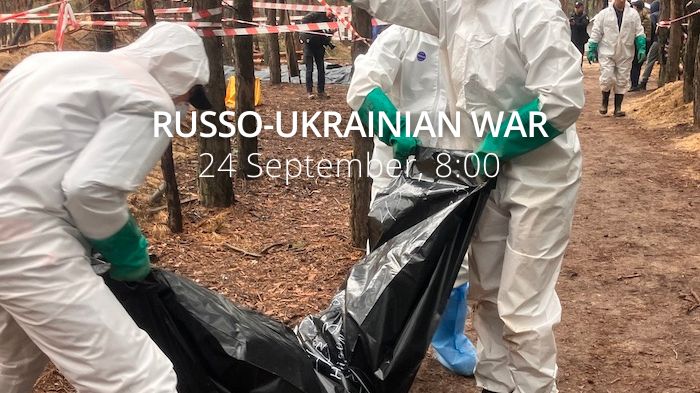Daily overview — Summary report, December 9
A map of the approximate situation on the ground in Ukraine as of 00:00 UTC 09/12/22.
— War Mapper (@War_Mapper) December 9, 2022
There have been no notable changes to control since the last update. pic.twitter.com/cLofL8gVTA
The General Staff’s operational update regarding the Russian invasion as of 06.00 am, December 9, 2022 is in the dropdown menu below:
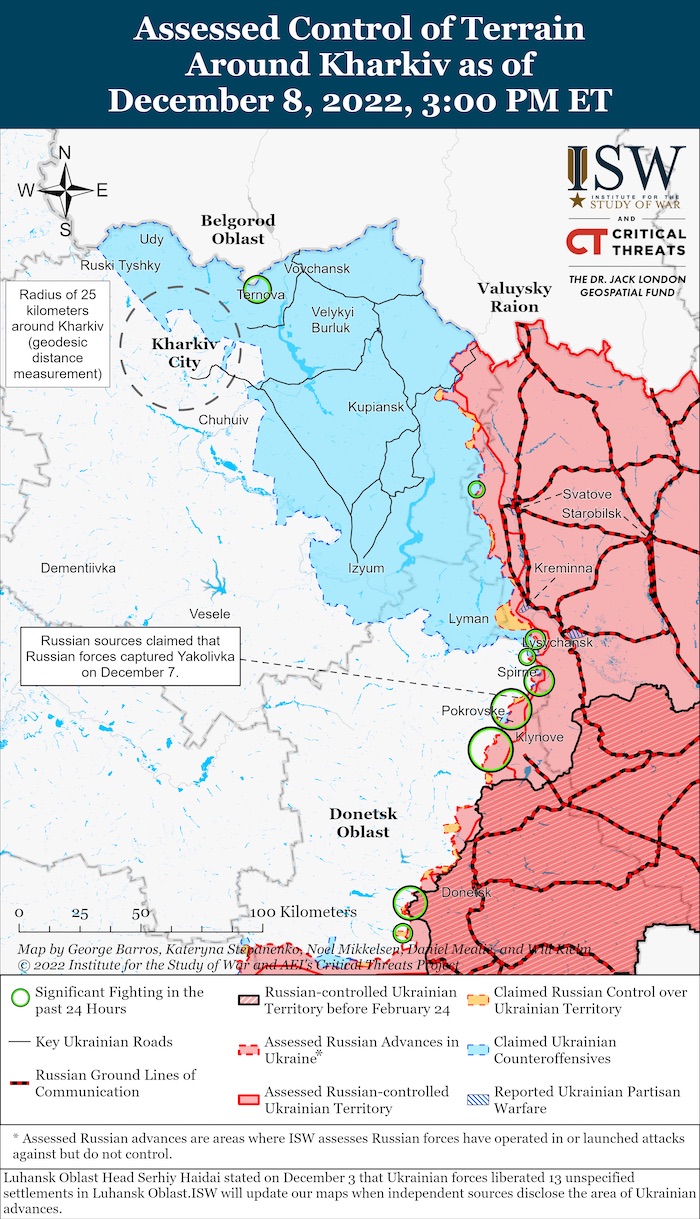
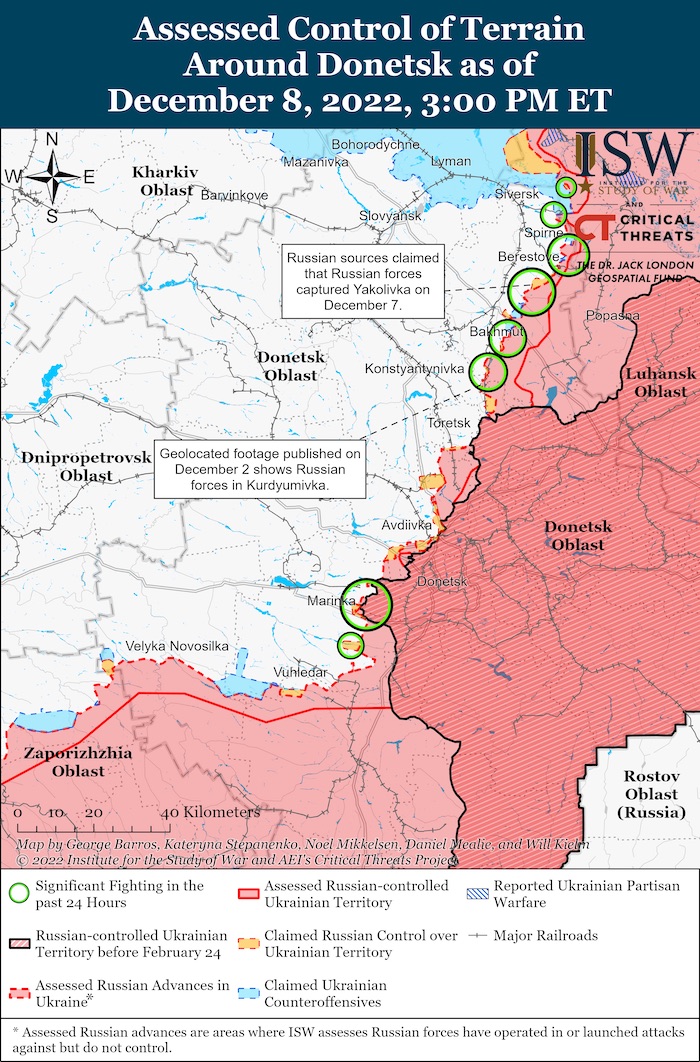
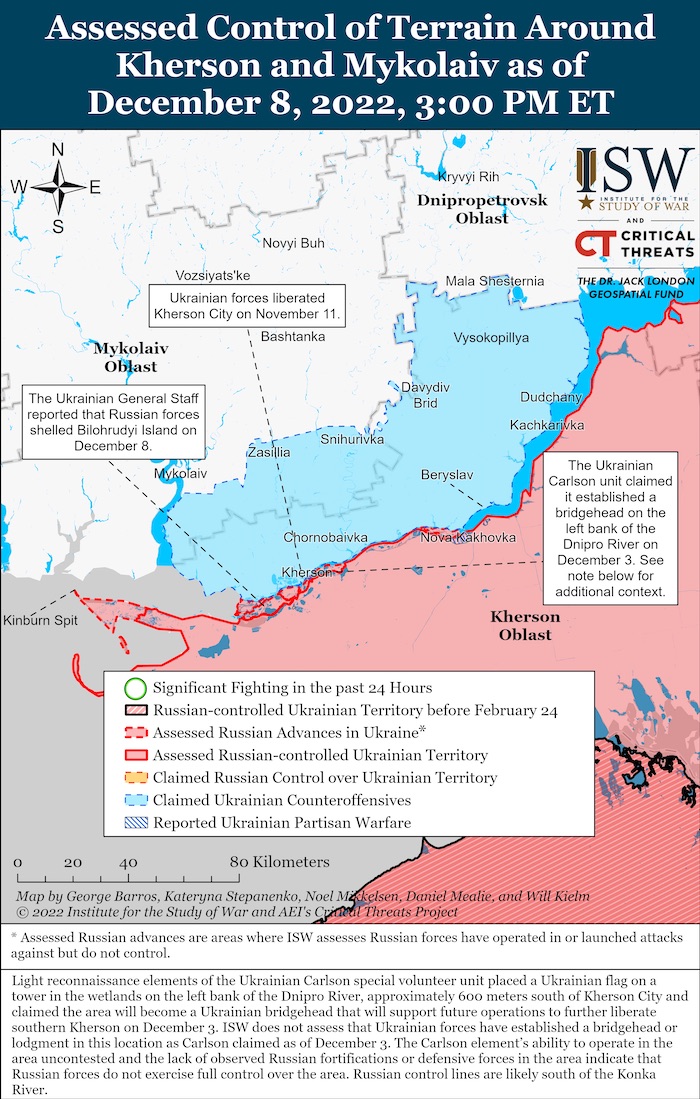
Military Updates
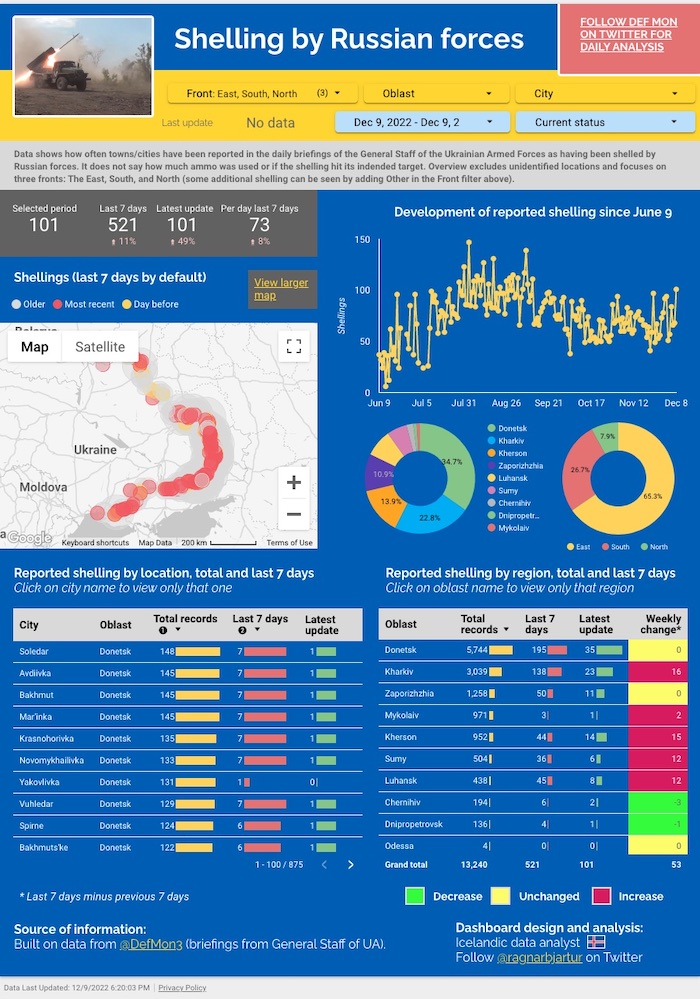
Good news may soon come from the front in Luhansk Oblast – Oblast Head. The armed forces of Ukraine are slowly advancing in the direction of Svatove-Kreminna. Luhansk Oblast head Serhiy Haidai believes there will be good news on the frontline from Luhansk Oblast soon.
“Russia has made a catastrophic mistake,” British Royal Navy Adm said. Putin has failed across the board during 10 months of the war against Ukraine, US Army Gen. Mark A. Milley said. The Ukrainians defeated the initial attack on Kyiv and then more than held their own in the battles in the eastern part of the nation. Ukrainian forces launched a counterattack in Kharkiv that drove the Russians back from the second-largest city in the country and then pushed the Russians out of the strategic city of Kherson, Milley said. But “there’s still a significant amount of fighting to go,” Milley said.
According to British Defence Intelligence, (last 48 hours):
- For the first time in three weeks, there have been reports of attacks by Iranian-provided one-way attack (OWA) uncrewed aerial vehicles (UAVs). These events remain to be verified, but it is likely that Russia exhausted its previous stock of several hundred Shahed-131s and 136s and has now received a resupply.
- On 06 December 2022, the Ukrainian General Staff reported shooting down 17 UAVs, including 14 Shahed-136s. On 07 December 2022, Ukrainian officials reported the use of Iranian-provided OWA UAVs targeting Zaporizhzhia and Dnipro oblasts.
- The last previously reported shooting down of Iranian Shahed-136s in Ukraine was on 17 November 2022. If verified, it is likely that Russia has recommenced attacks with newly delivered OWA UAV systems.
Losses of the Russian army
The total combat losses of the enemy from 24.02.2022 to 09.12.2022 were approximately:- personnel ‒ about 93390 (+310) persons were liquidated,
- tanks ‒ 2937 (+0),
- APV ‒ 5912 (+1),
- artillery systems – 1926 (+1),
- MLRS – 395 (+0),
- anti-aircraft warfare systems ‒ 211 (+0),
- aircraft – 281 (+0),
- helicopters – 264 (+0),
- UAV operational-tactical level – 1603 (+0),
- cruise missiles ‒ 592 (+0),
- warships / boats ‒ 16 (+0),
- vehicles and fuel tanks – 4531 (+3),
- special equipment ‒ 164 (+0).
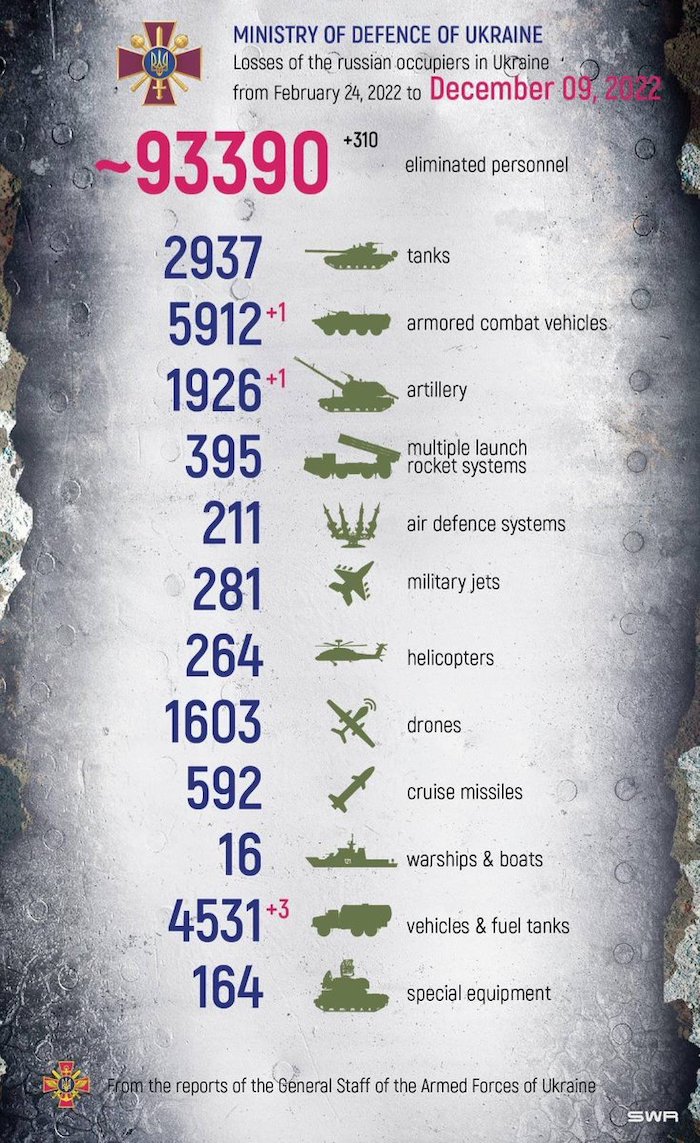
Humanitarian
https://twitter.com/EuromaidanPress/status/1600967957177282560Russia kicks out civilians from hospitals to make room for its WIA in Luhansk Oblast’s occupied part – National Resistance Center. Hospitals located in the temporarily occupied areas of Luhansk Oblast forcefully expel patients who have not yet completed treatment. People with complex injuries, even those who were blown up by Russian mines must make way for the Russian military, Ukraine’s Center of National Resistance reports.
https://twitter.com/EuromaidanPress/status/1600917977561726977️Environment
https://twitter.com/EuromaidanPress/status/1600883024773541888 Russia deploys multiple-launch rocket systems to Zaporizhzhia nuclear plant – Enerhoatom. Russia stages a provocation at Zaporizhzhia nuclear power plant that it controls, Ukraine’s state-owned nuclear energy operator Enerhoatom warns. On 7 December 2022, the Russian military placed several multiple-launch rocket systems (MLRS) “Grad” near one of the nuclear reactors at Zaporizhzhia nuclear power plant (ZNPP), right next to the territory of the plant’s dry cask storage of spent nuclear fuel, according to Enerhoatom. Price cap on Russian oil can work only if lowered to 35 USD instead of 60 USD – Ukraine’s Economy Minister. The new Price Cap Policy mechanism has significant potential but price restrictions for Russia must be revised downwards, Ukraine’s Minister of Economy Yulia Svyrydenko said. https://twitter.com/EuromaidanPress/status/1600846382285586432Legal
Bodies of men with torture signs found after Russian occupation in Ukraine’s south. Ukrainian investigators found three bodies of men in Novopetrivka village of Snihurivka municipality, Mykolayiv Oblast. The area was liberated from Russian occupation by Ukrainian forces on 11 November 2022. Forced deportation of Ukrainian children to Russia is a clear act of genocide. Ukrainian human rights groups have monitored Russia’s kidnapping of children from occupied parts of Ukraine and are in no doubt that such enforced deportation and attempts to turn Ukrainian children into ‘Russians’ are acts of genocide. Russia is also using children for cynical propaganda purposes, with a new study reporting that many children were apparently adopted’ by Russians only to be ‘returned’, like unwanted goods, when the Russians discovered that they had health problems. The Russian occupation ‘authorities’ are now, at least, carrying out medical examinations first, although the fact that ‘unhealthy children’ get left behind will certainly not be admitted on the propaganda videos about Russians supposedly ‘saving’ Ukrainian children.Three bodies of men with traces of torture were found in their village after the Russian occupation in Ukraine’s south
— Euromaidan Press (@EuromaidanPress) December 8, 2022
Two men had gunshot wounds, prosecutor's office said. https://t.co/eiR4gQ6X89 pic.twitter.com/p63AiFSx2p
Forced #deportation of children from occupied #Ukraine to #Russia is a clear act of #genocide #StandWithUkraine #RussiaWarCrimes #StopRussia #Lvova-Belova https://t.co/gO99pGR38U pic.twitter.com/3iH8x9j7eU
— Halya Coynash (@halyapuff) December 9, 2022
Support
https://twitter.com/EuromaidanPress/status/1600808008178552832 Australian company releases Kherson Liberation Gin to raise money for de-mining in Ukraine. The Australian gin company has produced a limited edition of dry gin to celebrate the liberation of the Ukrainian city of Kherson and raise money to clear mines in Ukraine.Slovakia to send Ukraine ammunition for aircraft, 300 generators. The Slovak government approved a new package of military aid to Ukraine on 7 December. It includes ammunition for fighter jets, warm clothes for the military, and other equipment.
New Developments
https://twitter.com/EuromaidanPress/status/1601000421388156928 Italy’s opera house staged Russian opera despite Ukrainian protests; von der Leyen and Meloni visit it – AP. Italy’s most treasured opera house, Teatro alla Scala, opened its new season Wednesday with the Russian opera “Boris Godunov,” against the backdrop of Ukrainian protests that the cultural event is a propaganda win for the Kremlin during Russia’s invasion of Ukraine, AP reports. https://twitter.com/EuromaidanPress/status/1600848923358208001 Putin admits that Russian army strives to destroy critical civilian infrastructure in Ukraine. Russia seeks to destroy Ukraine’s energy system in order to retaliate for Ukrainian strikes on the Crimean bridge, Russian President Vladimir Putin claimed in his interview with the Russian state-owned news agency RIA Novosti. European Parliament will vote on the recognition of Holodomor as genocide on 15 December. The Holodomor was a Soviet-made famine that killed millions of Ukrainians in 1932-1933 after food stocks were forcibly taken away from Ukrainian collective and individual farms and cities. Soviet authorities forbid Ukrainian peasants to leave Ukraine during the famine.Moscow again using and trapped by conspiracy theories to justify Russia’s fight against the West, anthropologist says
Assessment
- On the war.
The Institute for the Study of War has made the following assessment as of December 8, 2022:
- German Chancellor Olaf Scholz stated that the risk of Russian nuclear escalation is low.
- Chairman of the Joint Chief of Staff General Mark Milley stated that fighting may intensify in Ukraine during the winter.
- The Kremlin has likely not abandoned its maximalist goals in Ukraine despite Dmitry Pskov’s comments on Russian territorial objectives.
- The Kremlin’s Western-orientated messaging continues to anger the pro-war milblogger community.
- Russian President Vladimir Putin may be distancing his rhetoric from nationalists’ unrealistic demands for the Russian war in Ukraine.
- A senior Kremlin official admitted that the Kremlin tolerates criticism from the pro-war milblogger community out of a desire to appeal to the wider nationalist community.
- Ukrainian officials stated that Russian forces further militarized the Zaporizhzhia Nuclear Power Plant (ZNPP).
- Russian forces reinforced positions near Svatove and conducted counterattacks near Kreminna amid continued Ukrainian counteroffensive operations in eastern Ukraine.
- Russian forces continued offensive operations in the Bakhmut and Avdiivka–Donetsk City areas.
- A Russian government official implied that Putin’s word is law when it comes to the military mobilization of Russian citizens.
- Russian occupation officials increased security measures in Russian-occupied territories in Ukraine.


